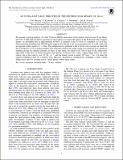AN ULTRA-FAST X-RAY DISK WIND IN THE NEUTRON STAR BINARY GX 340+0
Author(s)
Miller, J. M.; Raymond, J.; Cackett, E.; Grinberg, Victoria; Nowak, Michael A.
DownloadMiller-2016-AN ULTRA-FAST X-RAY.pdf (420.0Kb)
PUBLISHER_POLICY
Publisher Policy
Article is made available in accordance with the publisher's policy and may be subject to US copyright law. Please refer to the publisher's site for terms of use.
Terms of use
Metadata
Show full item recordAbstract
We present a spectral analysis of a brief Chandra/HETG observation of the neutron star low-mass X-ray binary GX 340+0. The high-resolution spectrum reveals evidence of ionized absorption in the Fe K band. The strongest feature, an absorption line at approximately 6.9 keV, is required at the 5σ level of confidence via an F-test. Photoionization modeling with XSTAR grids suggests that the line is the most prominent part of a disk wind with an apparent outflow speed of v = 0.04c. This interpretation is preferred at the 4σ level over a scenario in which the line is H-like Fe xxvi at a modest redshift. The wind may achieve this speed owing to its relatively low ionization, enabling driving by radiation pressure on lines; in this sense, the wind in GX 340+0 may be the stellar-mass equivalent of the flows in broad absorption line quasars. If the gas has a unity volume filling factor, the mass ouflow rate in the wind is over 10⁻⁵ M ⊙ yr⁻¹, and the kinetic power is nearly 10³⁹ erg s⁻¹ (or, 5–6 times the radiative Eddington limit for a neutron star). However, geometrical considerations—including a small volume filling factor and low covering factor—likely greatly reduce these values.
Date issued
2016-04Department
MIT Kavli Institute for Astrophysics and Space ResearchJournal
Astrophysical Journal. Letters
Publisher
IOP Publishing
Citation
Miller, J. M., J. Raymond, E. Cackett, V. Grinberg, and M. Nowak. “AN ULTRA-FAST X-RAY DISK WIND IN THE NEUTRON STAR BINARY GX 340+0.” The Astrophysical Journal 822, 1 (April 2016): L18 © 2016 The American Astronomical Society
Version: Final published version
ISSN
2041-8213
2041-8205